
Bobby Isaac may not be a household name with today’s NASCAR fans, but in his hay day, he was a force to be reckoned with on and off the track. Early in his career, Isaac was known for winning the race or swinging fists after it ended.
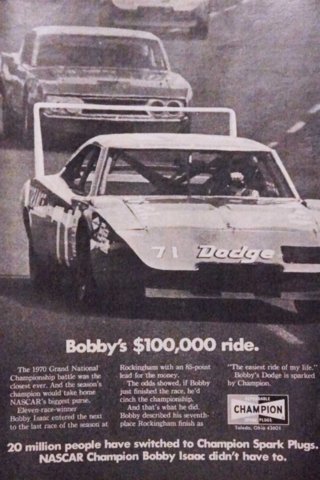
Above: In 1970, Bobby Isaac won the NASCAR Grand National Championship with his Hemi-powered 1969 Dodge Daytona. During the late-’60s and early-’70s, the aero wars were hot among the “big three” auto manufacturers. The winged cars were a force to be reckoned with during that time, and Champion was along for the ride.
His brawling led to severe fines and, finally, an ultimatum from NASCAR executive manager Pat Purcell stating NASCAR will be fine without you, but will you be okay without NASCAR? After that conversation, Isaac cleaned up his act.
Isaac dropped out of school at a young age, but his lack of education never slowed him down. He started racing in 1956, progressed to NASCAR in 1961, and won his first race by 1964, the Daytona 500.
Isaac qualified on the pole twenty times in 1969, which is still a NASCAR record. Before his career ended in 1976, he won 37 NASCAR races. He reached the pinnacle of the Grand National Series by winning the 1970 championship in his 1969 Dodge Daytona powered by Champion Spark Plugs, as described in the March 1971 Hot Rod Magazine advertisement.
When NASCAR significantly reduced the legal cubic inch displacement of the engines for aero cars in 1971, Isaac returned to a wingless Charger to remain competitive in the Grand National Series. However, the Daytona was pulled out of the mothballs and run at the Bonneville Salt Flats.
Isaac and crew were able to set twenty-eight records during the short time on the salt. Many of the records remain today. As with his NASCAR championship, Isaac set the records with Champion Spark Plugs screwed into the Hemi, as depicted in the 1972 Car and Driver Magazine ad.
Above Left: At the age of 37, Isaac raced 47 of the 48 NASCAR races to his championship in 1970. Between the ’69 and ’70 seasons, Isaac won 28 of his 37 career NASCAR wins. (Photographer Unknown) Right: Isaac qualified on the pole for 20 races in ’69 and 13 races in ’70. He earned almost $300,000 during those two years. (David Bryant Photo)
Isaac abruptly (but temporarily) ended his racing career, electing to pull off the track during the 1973 Talladega 500. In 1974, he reentered the driver’s seat part-time, but his past success did not return with him. By 1976, his NASCAR career had ended.
Sadly, on August 14, 1977, after needing a relief driver during the Winston 200 late-model sportsman race at Hickory Motor Speedway, Isaac died at the young age of 45 from a heat exhaustion-induced heart attack. Posthumously, Isaac was named one of NASCAR’s Fifty Greatest Drivers and was inducted into the National Motorsports Press Association, International Motorsports, and NASCAR Halls of Fame.
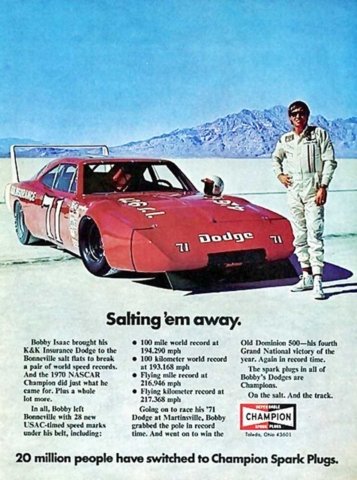
Above: In 1971, NASCAR substantially penalized the aero cars, including the Mopar “winged warriors.” Although the cars could race, NASCAR limited the engine displacement was to 5-liters (305 CID) rather than the larger 7-liters (426 CID) for the non-winged cars. NASCAR’s rule change effectively ended the aero wars. Isaac and his crew took their Daytona to Bonneville and set 28 records. Champion Spark Plugs helped Isaac’s 426 Hemi set the records.
The history of Champion spark plugs starts with Albert Champion in 1905. Along with the Stranahan brothers, he founded the Albert Champion Company that produced porcelain spark plugs and imported various electrical ignition components from France.
By 1908, Albert Champion left (or was pushed out of) his company. Champion met with William Durant of the Buick Motor Company to discuss manufacturing spark plugs for all Buick automobiles.
The two started a new business, but the Champion name could not be used as the Stranahan brothers had trademarked it, so Durant and Champion named the new company AC Spark Plug (A.C. for Albert Champion).
The Champion business, owned by the Stranahan brothers, developed the first suppression plug in 1931. It consisted of a carbon-based resistor, which reduced the influences of ignition noise and radio wave interference.
Champion sponsored many racers and race events over the years, and the plugs were original equipment parts for most Mopars from the 1960s to the early 2000s.
Above Left: Isaac’s Daytona performed straight-line runs, and for some of the longer 10-mile runs, it ran in a large diameter circle. (Photographer Unknown) Above Right: The ’69 Daytona was immortalized in plastic. MPC molded the Daytona as a 1/25th scale replica of the full-sized version.
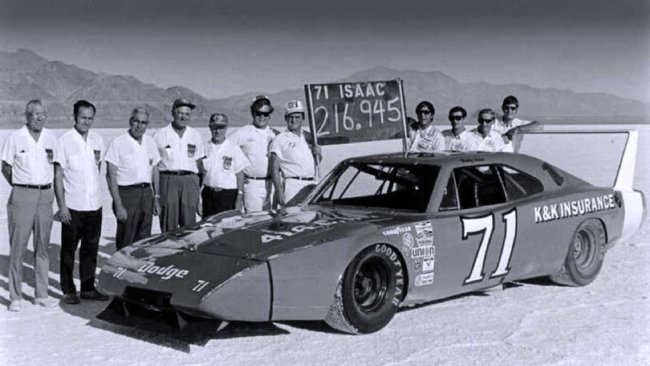
Above: Isaac and his crew pose behind the Hemi-powered Daytona on the Bonneville Salt Flats. One of the 28 records he set was the flying mile, officially certified at 216.945 mph. (Photographer Unknown)
In 1989, Cooper Industries acquired Champion, and now the company is a subsidiary of the Federal-Mogul Corporation which was acquired by Tenneco under the DRiV Incorporated umbrella in 2019. Champion still manufactures various plugs but now offers plug wires, batteries, glow plugs, windshield wipers, oil filters, and lighting products.
If Champion plugs are needed for your Mopar, they can be found at most auto parts outlets. However, if a more specific heat range, tip design, or reach cannot be found locally, Mancini Racing carries a complete line of Champion plugs.









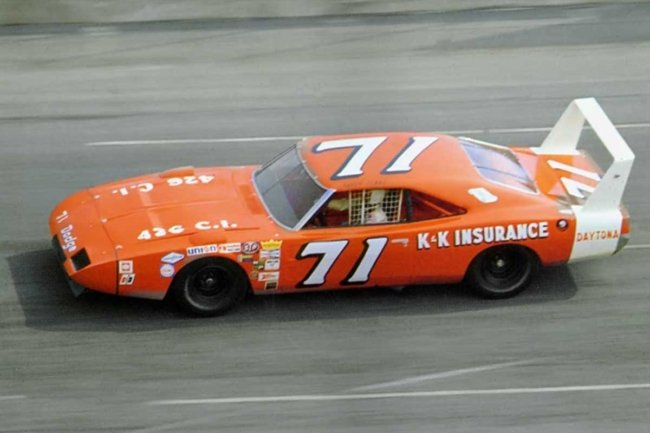


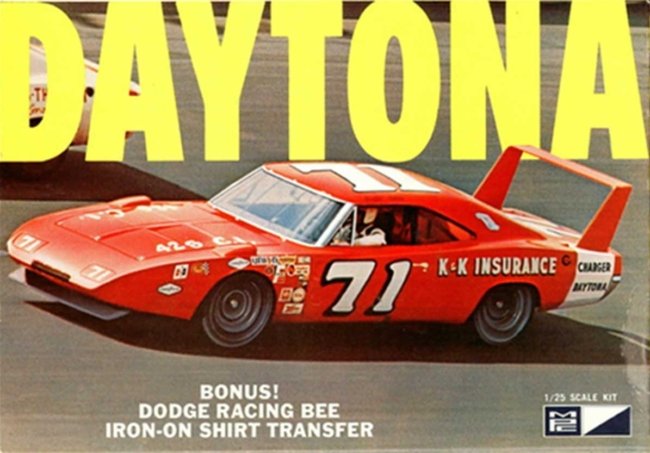




 Mopar Connection Magazine – The ONLY Daily Mopar Magazine © 2022. All Rights Reserved. Mopar Connection Magazine is the ONLY daily Mopar Magazine bringing you the latest Mopar news, technology, breaking news, and Mopar related events and articles. Find out the latest information about Mopar, Mopar products and services, stay up to date on Mopar enthusiast news, dealership information and the latest Mopar social media buzz! Sign up for the Mopar Connection Magazine newsletter for the latest information about new products, services and industry chatter. Mopar Connection Magazine is the best and only source you need to be a Mopar industry insider!
Mopar Connection Magazine – The ONLY Daily Mopar Magazine © 2022. All Rights Reserved. Mopar Connection Magazine is the ONLY daily Mopar Magazine bringing you the latest Mopar news, technology, breaking news, and Mopar related events and articles. Find out the latest information about Mopar, Mopar products and services, stay up to date on Mopar enthusiast news, dealership information and the latest Mopar social media buzz! Sign up for the Mopar Connection Magazine newsletter for the latest information about new products, services and industry chatter. Mopar Connection Magazine is the best and only source you need to be a Mopar industry insider! by
by